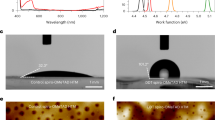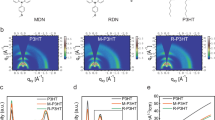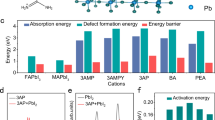Abstract
Stabilizing the best-performing state-of-the-art perovskite solar cells (PSCs) based on a spiro-OMeTAD hole transport material (HTM), without sacrificing their high power conversion efficiency (PCE) levels, is a challenging task. By exploiting the symmetry-tuned strategy at the molecular level, we have developed spiro-OMeTAD analogues (namely, the spiro-Naph series) with asymmetric phenylnaphthylamine edge units. The new spiro-Naph HTM-based PSC achieved a high PCE of 24.43%, higher than that achieved with spiro-OMeTAD. In addition to excellent stability when soaking the encapsulated device with continuous light, superior device stability was also obtained for the unencapsulated spiro-Naph-based PSC—a PCE of 21.12% was retained in air with ~25% relative humidity after 2,000 h and a PCE of 18.79% was retained at an elevated temperature of 60 °C after 400 h. We also constructed a spiro-Naph-based large-area module (25 cm2) with a PCE of 21.83%.
This is a preview of subscription content, access via your institution
Access options
Access Nature and 54 other Nature Portfolio journals
Get Nature+, our best-value online-access subscription
$29.99 / 30 days
cancel any time
Subscribe to this journal
Receive 12 print issues and online access
$209.00 per year
only $17.42 per issue
Buy this article
- Purchase on Springer Link
- Instant access to full article PDF
Prices may be subject to local taxes which are calculated during checkout





Similar content being viewed by others
Data availability
All relevant data that support the plots within this paper and other findings of this study are available from the corresponding authors upon reasonable request.
References
Kojima, A., Teshima, K., Shirai, Y. & Miyasaka, T. Organometal halide perovskites as visible-light sensitizers for photovoltaic cells. J. Am. Chem. Soc. 131, 6050–6051 (2009).
Bush, K. A. et al. 23.6%-efficient monolithic perovskite/silicon tandem solar cells with improved stability. Nat. Energy 2, 17009 (2017).
Grätzel, M. The rise of highly efficient and stable perovskite solar cells. Acc. Chem. Res. 50, 487–491 (2017).
Jeon, N. J. et al. Compositional engineering of perovskite materials for high-performance solar cells. Nature 517, 476–480 (2015).
Min, H. et al. Efficient, stable solar cells by using inherent bandgap of α-phase formamidinium lead iodide. Science 366, 749–753 (2019).
Snaith, H. J. Present status and future prospects of perovskite photovoltaics. Nat. Mater. 17, 372–376 (2018).
Best Research-Cell Efficiencies Chart (National Renewable Energy Laboratory, 2020); https://www.nrel.gov/pv/assets/pdfs/best-research-cell-efficiencies.20200218.pdf
Leijtens, T. et al. Stability of metal halide perovskite solar cells. Adv. Energy Mater. 5, 1500963 (2015).
Park, N.-G. et al. Towards stable and commercially available perovskite solar cells. Nat. Energy 1, 16152 (2016).
Wang, R. et al. A review of perovskites solar cell stability. Adv. Funct. Mater. 29, 1808843 (2019).
Bella, F. et al. Improving efficiency and stability of perovskite solar cells with photocurable fluoropolymers. Science 354, 203–206 (2016).
Heo, J. H. et al. Efficient inorganic–organic hybrid heterojunction solar cells containing perovskite compound and polymeric hole conductors. Nat. Photon. 7, 486–491 (2013).
Jiang, Q. et al. Surface passivation of perovskite film for efficient solar cells. Nat. Photon. 13, 460–466 (2019).
Jung, E. H. et al. Efficient, stable and scalable perovskite solar cells using poly(3-hexylthiophene). Nature 567, 511–515 (2019).
Liu, Y. et al. Ultrahydrophobic 3D/2D fluoroarene bilayer-based water-resistant perovskite solar cells with efficiencies exceeding 22%. Sci. Adv. 5, eaaw2543 (2019).
Seok, S. I., Grätzel, M. & Park, N.-G. Methodologies toward highly efficient perovskite solar cells. Small 14, 1704177 (2018).
Yang, W. S. et al. Iodide management in formamidinium-lead-halide–based perovskite layers for efficient solar cells. Science 356, 1376–1379 (2017).
Calió, L., Kazim, S., Grätzel, M. & Ahmad, S. Hole-transport materials for perovskite solar cells. Angew. Chem. Int. Ed. 55, 14522–14545 (2016).
Jeon, N. J. et al. o-Methoxy substituents in spiro-OMeTAD for efficient inorganic–organic hybrid perovskite solar cells. J. Am. Chem. Soc. 136, 7837–7840 (2014).
Jeon, N. J. et al. A fluorene-terminated hole-transporting material for highly efficient and stable perovskite solar cells. Nat. Energy 3, 682–689 (2018).
Jeong, M. et al. Stable perovskite solar cells with efficiency exceeding 24.8% and 0.3-V voltage loss. Science 369, 1615–1620 (2020).
Petrus, M. L. et al. New generation hole transporting materials for perovskite solar cells: amide-based small-molecules with nonconjugated backbones. Adv. Energy Mater. 8, 1801605 (2018).
Urieta-Mora, J., García-Benito, I., Molina-Ontoria, A. & Martín, N. Hole transporting materials for perovskite solar cells: a chemical approach. Chem. Soc. Rev. 47, 8541–8571 (2018).
Yin, X., Song, Z., Li, Z. & Tang, W. Toward ideal hole transport materials: a review on recent progress in dopant-free hole transport materials for fabricating efficient and stable perovskite solar cells. Energy Environ. Sci. 13, 4057–4086 (2020).
Kim, G.-W. et al. Dopant-free polymeric hole transport materials for highly efficient and stable perovskite solar cells. Energy Environ. Sci. 9, 2326–2333 (2016).
Saliba, M. et al. A molecularly engineered hole-transporting material for efficient perovskite solar cells. Nat. Energy 1, 15017 (2016).
Zhang, F. et al. Polymeric, cost-effective, dopant-free hole transport materials for efficient and stable perovskite solar cells. J. Am. Chem. Soc. 141, 19700–19707 (2019).
Kim, H.-S. et al. Lead iodide perovskite sensitized all-solid-state submicron thin film mesoscopic solar cell with efficiency exceeding 9%. Sci. Rep. 2, 591 (2012).
Liu, X. et al. 20.7% highly reproducible inverted planar perovskite solar cells with enhanced fill factor and eliminated hysteresis. Energy Environ. Sci. 12, 1622–1633 (2019).
Luo, D. et al. Enhanced photovoltage for inverted planar heterojunction perovskite solar cells. Science 360, 1442–1446 (2018).
Ke, W. et al. Dopant-free tetrakis-triphenylamine hole transporting material for efficient tin-based perovskite solar cells. J. Am. Chem. Soc. 140, 388–393 (2018).
Li, Z. A. et al. Rational design of dipolar chromophore as an efficient dopant-free hole-transporting material for perovskite solar cells. J. Am. Chem. Soc. 138, 11833–11839 (2016).
Liu, J. et al. A dopant-free hole-transporting material for efficient and stable perovskite solar cells. Energy Environ. Sci. 7, 2963–2967 (2014).
Liu, Y. et al. Perovskite solar cells employing dopant-free organic hole transport materials with tunable energy levels. Adv. Mater. 28, 440–446 (2016).
Molina-Ontoria, A. et al. Benzotrithiophene-based hole-transporting materials for 18.2% perovskite solar cells. Angew. Chem. Int. Ed. 55, 6270–6274 (2016).
Feng, S. et al. Fused-ring acceptors with asymmetric side chains for high-performance thick-film organic solar cells. Adv. Mater. 29, 1703527 (2017).
Li, C., Fu, H., Xia, T. & Sun, Y. Asymmetric nonfullerene small molecule acceptors for organic solar cells. Adv. Energy Mater. 9, 1900999 (2019).
Bin, H. et al. 11.4% efficiency non-fullerene polymer solar cells with trialkylsilyl substituted 2D-conjugated polymer as donor. Nat. Commun. 7, 13651 (2016).
Holliday, S. et al. High-efficiency and air-stable P3HT-based polymer solar cells with a new non-fullerene acceptor. Nat. Commun. 7, 11585 (2016).
Sun, Y. et al. Solution-processed small-molecule solar cells with 6.7% efficiency. Nat. Mater. 11, 44–48 (2012).
Zhou, R. et al. All-small-molecule organic solar cells with over 14% efficiency by optimizing hierarchical morphologies. Nat. Commun. 10, 5393 (2019).
Han, Q. et al. Single crystal formamidinium lead Iodide (FAPbI3): insight into the structural, optical and electrical properties. Adv. Mater. 28, 2253–2258 (2016).
Son, D.-Y. et al. Self-formed grain boundary healing layer for highly efficient CH3NH3PbI3 perovskite solar cells. Nat. Energy 1, 16081 (2016).
Chen, H. et al. Advances to high-performance black-phase FAPbI3 perovskite for efficient and stable photovoltaics. Small Struct. 2, 2000130 (2021).
Eperon, G. E. et al. Formamidinium lead trihalide: a broadly tunable perovskite for efficient planar heterojunction solar cells. Energy Environ. Sci. 7, 982–988 (2014).
Kim, M. et al. Methylammonium chloride induces intermediate phase stabilization for efficient perovskite solar cells. Joule 3, 2179–2192 (2019).
Wang, P. et al. Gradient energy alignment engineering for planar perovskite solar cells with efficiency over 23%. Adv. Mater. 32, 1905766 (2020).
Cohen, B.-E., Aharon, S., Dymshits, A. & Etgar, L. Impact of antisolvent treatment on carrier density in efficient hole-conductor-free perovskite-based solar cells. J. Phys. Chem. C 120, 142–147 (2016).
Luber, E. J. & Buriak, J. M. Reporting performance in organic photovoltaic devices. ACS Nano 7, 4708–4714 (2013).
Yin, X. et al. Binary hole transport materials blending to linearly tune HOMO level for high efficiency and stable perovskite solar cells. Nano Energy 51, 680–687 (2018).
Kim, Y. et al. Methoxy-functionalized triarylamine-based hole-transporting polymers for highly efficient and stable perovskite solar cells. ACS Energy Lett. 5, 3304–3313 (2020).
Park, S. J. et al. Inverted planar perovskite solar cells with dopant free hole transporting material: Lewis base-assisted passivation and reduced charge recombination. J. Mater. Chem. A 5, 13220–13227 (2017).
Meier de Andrade, A., Kullgren, J. & Broqvist, P. Quantitative and qualitative performance of density functional theory rationalized by reduced density gradient distributions. Phys. Rev. B 102, 075115 (2020).
Surov, A. O. et al. Specific features of supramolecular organisation and hydrogen bonding in proline cocrystals: a case study of fenamates and diclofenac. CrystEngComm 20, 6970–6981 (2018).
Frisch, M. J. et al. Gaussian 16, Revision C.01 (Gaussian, 2016).
Becke, A. D. Density‐functional thermochemistry. III. The role of exact exchange. J. Chem. Phys. 98, 5648–5652 (1993).
Martínez, L., Andrade, R., Birgin, E. G. & Martínez, J. M. PACKMOL: a package for building initial configurations for molecular dynamics simulations. J. Comput. Chem. 30, 2157–2164 (2009).
Kresse, G. & Hafner, J. Ab initio molecular dynamics for liquid metals. Phys. Rev. B 47, 558–561 (1993).
Tkatchenko, A. & Scheffler, M. Accurate molecular van der Waals interactions from ground-state electron density and free-atom reference data. Phys. Rev. Lett. 102, 073005 (2009).
Acknowledgements
This work was supported by a National Research Foundation of Korea (NRF) grant funded by the Korean government (MSIP; 2021R1A2C3004202), the Wearable Platform Materials Technology Center (2016R1A5A1009926) funded by the Korean Government (MSIT), the Technology Development Program to Solve Climate Changes of the National Research Foundation (NRF) funded by the Ministry of Science, ICT and Future Planning (2020M1A2A2080746), and the Research Project funded by Ulsan City (1.210058.01) of UNIST (Ulsan National Institute of Science and Technology), Korea Institute of Energy Technology Evaluation and Planning (KETEP) grant funded by the Korea government (MOTIE) (20193091010460, Development of Super Solar cells for overcoming the theoretical limit of silicon solar cell efficiency (>30%)), the Development Program of the Korea Institute of Energy Research (KIER; C1-2401 and C1-2402).
Author information
Authors and Affiliations
Contributions
C.Y., D.S.K. and C.-W.L. conceptualized and supervised the project. J.-H.B. advised on the research. M.J. and S.J. synthesized and characterized the HTM materials. I.W.C. fabricated and characterized the perovskite films and solar cells and carried out the stability test. K.Y. performed the molecular simulations. M.K. performed the SCLC measurements. S.J.C. and Y.J. carried out TRPL measurements. Y.C. performed contact angle measurements. J.-H.A. carried out conductivity measurements. H.-B.K. fabricated the large-area module. S.-H.K. performed the NMR measurements. C.Y., D.S.K. and M.J. wrote the manuscript and all authors reviewed the manuscript.
Corresponding authors
Ethics declarations
Competing interests
The authors declare no competing interests.
Peer review
Peer review information
Nature Photonics thanks Nazario Martin and the other, anonymous, reviewer(s) for their contribution to the peer review of this work.
Additional information
Publisher’s note Springer Nature remains neutral with regard to jurisdictional claims in published maps and institutional affiliations.
Supplementary information
Supplementary Information
Supplementary Methods, Figs. 1–31 and Tables 1–5.
Supplementary Video 1
Perovskite solar module PCE measurement video.
Rights and permissions
About this article
Cite this article
Jeong, M., Choi, I.W., Yim, K. et al. Large-area perovskite solar cells employing spiro-Naph hole transport material. Nat. Photon. 16, 119–125 (2022). https://doi.org/10.1038/s41566-021-00931-7
Received:
Accepted:
Published:
Issue Date:
DOI: https://doi.org/10.1038/s41566-021-00931-7
This article is cited by
-
Iodide manipulation using zinc additives for efficient perovskite solar minimodules
Nature Communications (2024)
-
Ultrastable halide perovskite CsPbBr3 photoanodes achieved with electrocatalytic glassy-carbon and boron-doped diamond sheets
Nature Communications (2024)
-
Stabilizing semi-transparent perovskite solar cells with a polymer composite hole transport layer
Nano Research (2024)
-
Recent progress in the development of high-efficiency inverted perovskite solar cells
NPG Asia Materials (2023)
-
Engineering the buried interface in perovskite solar cells via lattice-matched electron transport layer
Nature Photonics (2023)



